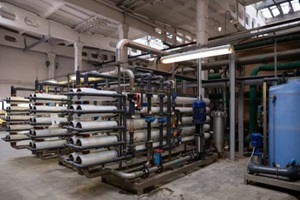 Water is a fundamental resource that supports all ecosystems. However, due to human activities and pollution, public water may contain harmful substances that can adversely affect people’s health.
Water is a fundamental resource that supports all ecosystems. However, due to human activities and pollution, public water may contain harmful substances that can adversely affect people’s health.
One of the common chemicals found in public water supplies is chlorine. While chlorine kills bacteria and other harmful microorganisms, there are various concerns about its long-term effects on health.
Exposure to high chlorine levels has been linked to respiratory problems, skin irritation, and increased risk of certain types of cancer.
Various effective water filtration systems, such as reverse osmosis and activated carbon filters, can significantly improve the quality of public water.
Disinfectants in Public Water
Public water is sourced from rivers, lakes, and groundwater reservoirs. Before it reaches the tap, it goes through several treatment processes. Some of these processes include the use of chemicals that can introduce harmful byproducts, as shown below:
Chlorine
Chlorine reacts with naturally occurring organic matter to create disinfection byproducts (DBPs) such as trihalomethanes (THMs) and haloacetic acids (HAAs). These byproducts have been shown to cause adverse health effects.
Fluoride
Fluoride is also added to prevent tooth decay. Excess use of this compound may lead to skeletal fluorosis, which causes bone and joint pain.
Chloramines
Some water treatment facilities have switched to using chloramines instead of chlorine. This compound of chlorine and ammonia is believed to be less harmful than chlorine as it’s less likely to form disinfection byproducts. However, it can cause health concerns such as skin irritation and respiratory problems.
Aluminum Sulfate
Aluminum sulfate is added during coagulation to help remove particles and impurities from the water. However, this can result in high levels of aluminum in drinking water, which has been linked to neurological disorders such as Alzheimer’s disease.
Polyphosphate
Polyphosphate is a commonly used chemical in water treatment to control scale buildup in pipes. It’s generally considered safe for human consumption at the low levels typically found in treated water. However, excessive intake can cause gastrointestinal discomfort.
Ozone
 Ozone is a powerful oxidant used to disinfect water. It’s highly effective at killing bacteria but can also react with organic matter and form byproducts such as bromate.
Ozone is a powerful oxidant used to disinfect water. It’s highly effective at killing bacteria but can also react with organic matter and form byproducts such as bromate.
This compound is considered a human carcinogen by several organizations and has been linked to cancer, particularly bladder cancer.
Beyond Disinfectants: Other Contaminants in Public Water
Many contaminants lurk in public water supplies besides additives. These include the following:
Heavy Metals
Heavy metals such as lead, copper, and mercury can lead to various health concerns, especially among young children and pregnant women. These contaminants typically infiltrate the water from plumbing and industrial discharges.
Pharmaceuticals
Continuous disposal of medications has led to the prevalence of pharmaceutical residues in water sources. The majority of these medications seep into groundwater. They usually affect the hormone balance and other critical biological processes in the body.
Industrial Pollutants
Chemicals from industrial processes, including solvents and petrochemicals, form another category of water pollutants. These are particularly harmful as their presence, even in trace amounts, may have significant ecological and health-related consequences.
Agrichemicals
Residues of agrochemicals, particularly pesticides and fertilizers, usually seep underground and find their way into water sources. They can impact human life by causing various health problems.
The Impact on Human Health
The ingestion of contaminated water can result in various health problems, ranging from immediate illness to chronic diseases that can appear years after exposure.
Short-Term Effects
Acute health effects from water contamination result from microbial pathogens, such as bacteria and viruses. These microbes can cause diseases such as gastroenteritis and waterborne diseases. Skin irritation and respiratory issues are other common short-term effects of water contaminants.
Long-Term Health Risks
Specific contaminants accumulate in the body over time, leading to chronic conditions that significantly reduce the quality of life and life expectancy. These include cancer, kidney disease, and neurological disorders.
Hawaii’s Water Quality Concerns
Hawaii’s unique geographical and environmental characteristics present challenges for preserving water purity. The islands’ isolation shapes a dependency on groundwater, which is susceptible to contamination.
 The island’s volcanic nature also risks natural contaminants such as arsenic and radon seeping into the water supply. Also, Hawaii’s agricultural activities can result in pesticide and fertilizer runoffs that pollute water sources.
The island’s volcanic nature also risks natural contaminants such as arsenic and radon seeping into the water supply. Also, Hawaii’s agricultural activities can result in pesticide and fertilizer runoffs that pollute water sources.
Residents usually rely on bottled water or water filtration systems to address these challenges. The former could be better cost-wise and has negative environmental impacts.
It may also need to be more efficient as many bottled water brands have been found to have the same amount of contaminants as tap water.
Start the Journey Toward Water Purity With Hawaiian Cool Water
Hawaiian Cool Water offers sustainable water filtration solutions for Hawaii households and businesses. They provide various filtration systems, including reverse osmosis, carbon filtration, and water softening options at competitive prices. Contact Hawaiian Cool Water today to start the journey toward water purity.


